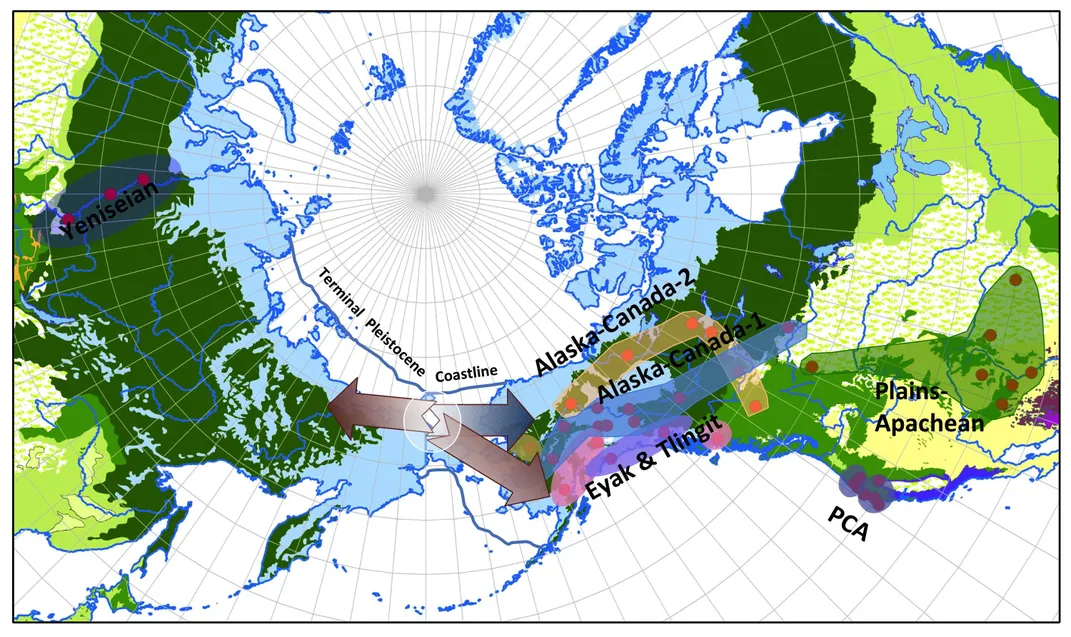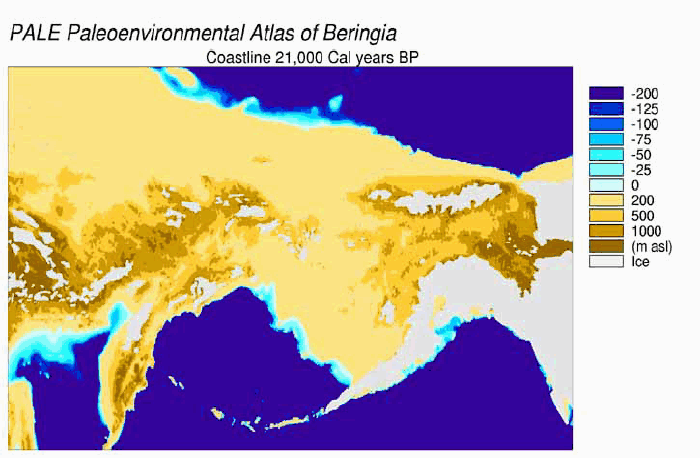/https://tf-cmsv2-smithsonianmag-media.s3.amazonaws.com/filer/40/02/4002eb4f-b611-40a2-b00f-6c1ee1977eee/beringiamap18kya_300dpi.jpg)
Russia and Alaska’s current coastlines (the dashed black lines), compared to ancient Beringia (shown in green), the land bridge that brought humans to North America.
Image via William Manley, Institute of Arctic and Alpine Research, University of Colorado.
A few weeks ago, scientists announced an intriguing finding about the ancestors of today’s Native Americans. Previously, genetic analysis had indicated that they’d left Siberia to migrate across ancient Beringia (the strip of land that once connected Asia and what’s now Alaska) about 25,000 years ago, but the earliest evidence of human habitation on North America dates to 15,000 years ago.
In reconstructing the ancient Beringian environment, the researchers provided a new clue that could help explain this discrepancy. They drilled into the Bering Sea between Siberia and Alaska and recovered sediment cores, and found that they contained plant fossils and pollen from a wooded ecosystem. Such an ecosystem, the authors argue, would have been an ideal place for humans to live. And with ice covering much of Alaska, the ancestors of Native Americans needn’t have just strolled through Beringia, they suggested—they could have lived there for about 10,000 years before moving on.
Now, more evidence for the idea comes from a seemingly unlikely source: languages still spoken in Asia and North America today. A pair of linguistics researchers, Mark Sicoli and Gary Holton, recently analyzed languages from North American Na-Dene family (traditionally spoken in Alaska, Canada and parts of the present-day U.S.) and the Asian Yeneseian family (spoken thousands of miles away, in central Siberia), using similarities and differences between the languages to construct a language family tree.
As they note in an article published today in PLOS ONE, they found that the two language families are indeed related—and both appear to descend from an ancestral language that can be traced to the Beringia region. Both Siberia and North America, it seems, were settled by the descendants of a community that lived in Beringia for some time. In other words, Sicoli says, “this makes it look like Beringia wasn’t simply a bridge, but actually a homeland—a refuge, where people could build a life.”

The analysis shows Beringia (white circle) to be the source of a diffusion of related language groups in both Siberia (dark blue) and North America (yellow, light blue, pink, purple, and green). PCA is Pacific Coast Athabascan.
Image via PLOS ONE/Sicoli and Holton
Sicoli began looking into the relationships between languages to model migration in the region several years ago, when he was with Holton at the University of Alaska (Sicoli is now at Georgetown University). The relationship between Yenesian and Na-Dene languages—which would theoretically serve as proof that Native Americans’ ancestors had migrated from Asia—was proposed as far back as 1923, by Italian linguist Alfredo Trombetti, but the first rigorous research to prove the link was only conducted over the past decade or so.
Sicoli and Holton sought to go a step further: They wanted to not only show the two groups were related, but analyze the similarities and differences between languages in the two families to paint a geographic picture of this ancient migration.
To do so, they relied upon software programs that conduct phylogenetic analyses. Most often, phylogenetics refers to sorting out the evolutionary relationships between different organisms, using genetic similarities and differences to construct an accurate family tree of species. But because languages, like life, gradually evolve over time, linguists have put the same sort of analysis to work in constructing language trees.
The researchers collected data on two Yeniseian languages, 37 Na-Dene languages and Haida (a language spoken on Canada’s Pacific coast but not believed to be related to Na-Dene, used as a control) from the Alaska Native Language Archive and several other published sources. Then, they used phylogenetic algorithms to create a family tree of the forty languages, determining which were most closely related based on the number of similarities (such as phonemes that serve particular roles in the language’s grammar, for instance).
Their tree confirmed that Yenesian and Na-Dene are related—and that Haida is not—but because these languages were carried by populations of humans that were moving over time, the lengths of branches in the tree also allowed Sicoli and Horton to weigh the odds of two different migration hypotheses. The first, proposed by many linguists, held that the source of both the Yenesian and Na-Dene languages was in Asia, with a subset of its speakers migrating across Beringia and bringing evolved versions of the language to North America. The second held that the source was in Beringia itself, with subsets of its speakers fanning out over both Siberia and North America.
The phylogenetic analysis, based on the degree of similarities between Yenesian and Na-Dene languages and within both groups, strongly supported the latter hypothesis—meaning that residents of communities as far apart as Central Siberia and the Great Plains share common ancestors, who likely lived in Beringia for an extended period of time.
“Growing up, I’d look at maps showing migrations to the Americas, and they’d always just show arrows going in one direction: straight across from Asia to North America,” Sicoli says. “What we see now is something more complicated, because some of those arrows go back to Siberia, and it wasn’t a non-stop trip.”
This fits with what we know about the geography of the region at the time. Asia and Alaska were connected by a land bridge because global sea levels were much lower, largely because of how much water was locked up in glaciers that covered much more of the planet than today. But even though these glaciers opened up the corridor between North America and Asia, they also closed the door, because, as mentioned before, Alaska itself was under a thick sheet of ice at that time.
Thus, the land bridge was a dead end, potentially explaining why these ancient migrants could have spent about 10,000 years in Beringia. Then, about 17,000 years ago, the glaciers began to recede—and sea levels began to rise—providing two reasons to leave Beringia, either for new territory in Alaska or back toward Siberia.

In the future, Sicoli plans to similarly model a greater range of Native American languages, to more broadly reconstruct the waves of migration that eventually brought the descendants of Beringia to present-day California and Central America.
The key, though, will be the work of linguists who are documenting quickly-disappearing indigenous languages before their final native speakers vanish. “A lot of the languages that can be used to answer these questions of ancient migrations are in the process of going extinct,” Sicoli says. “So to address these questions in the future, we need people to document these languages right now—otherwise, we’re losing our data faster than we can collect it.”

READ MORE
Calculating the Mass of Earth: How Much Does Earth Weigh?
Measuring Earth’s weight is derived from the gravitational attraction that the Earth has for objects [...]
Ask Smithsonian: Could the Volcano Beneath Yellowstone National Park Ever Erupt?
There are certainties and uncertainties in geology, but one definite is that if the massive [...]
Graphene oxide membranes reveal unusual behaviour of water at the nanoscale
Credit: AI-generated image Do more pores in a sieve allow more liquid to flow through [...]
5 Tips for Solving The New York Times Crossword Puzzle
Enjoying a crossword puzzle can help to keep you mentally fit. Chris Walton/South China Morning [...]
What Does a Harmonic Imbalancer Do?
Your car’s harmonic balancer absorbs engine vibrations and keeps them at a safe level. See [...]
Nanoenzymes designed with a unique combination of structure and functions
(A) Spatial organisation of the catalytic biostructures. (B) and (C) Detail of the two types [...]
10 Amazing Ancient Egyptian Inventions
Sure, the Great Pyramid is magnificent, but ancient Egyptians can take credit for a whole [...]
How to Install Gas Logs
It’s no wonder why gas logs are becoming more popular than traditional fireplaces. They require [...]